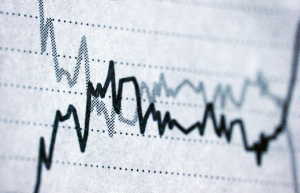Monday January 12, 2015
How To Handle Investment Volatility In Your Portfolio
 I’ve been in the financial services industry for two and a half full market cycles, and I’ve learned something about investor behavior during that time. When the market is generally going up, investors are overconfident in their ability to handle investment volatility. It’s when the market declines over a period of time (that we actually notice) or if it drops very quickly is when our long term game plan gets tossed out the window. The current bull market will turn 6 years old less than 2 months, but it hasn’t been all rainbows and unicorns getting here. From April 2010 to July 2010, the S&P 500 lost over 12%, from July 2011 to August 2011 the S&P 500 dropped 14%. More recently, January 2014 saw a 5% dip and October 2014 saw a 9% decline, the latter occurring in less than a week. Just last week the Dow dropped 0.75% and 1.8% on Monday and Tuesday, respectively. Ok ok, enough, I’m convinced nothing is ever tidy and smooth. So what is an investor to do?
I’ve been in the financial services industry for two and a half full market cycles, and I’ve learned something about investor behavior during that time. When the market is generally going up, investors are overconfident in their ability to handle investment volatility. It’s when the market declines over a period of time (that we actually notice) or if it drops very quickly is when our long term game plan gets tossed out the window. The current bull market will turn 6 years old less than 2 months, but it hasn’t been all rainbows and unicorns getting here. From April 2010 to July 2010, the S&P 500 lost over 12%, from July 2011 to August 2011 the S&P 500 dropped 14%. More recently, January 2014 saw a 5% dip and October 2014 saw a 9% decline, the latter occurring in less than a week. Just last week the Dow dropped 0.75% and 1.8% on Monday and Tuesday, respectively. Ok ok, enough, I’m convinced nothing is ever tidy and smooth. So what is an investor to do?
When Markets Decline, Your First Move
Is not to trade anything in your portfolio. If you’re uncomfortable with something you hear in the news, call your financial advisor and ask for their thoughts. A good financial advisor will discuss the long term results of sticking to the plan. Here’s a tip: if they say something like “Yeah, I saw that CNBC story too. I agree cutting our exposure to stocks is a wise idea, I’ll take care of it in your account right away.” you should immediately begin shopping for a new financial advisor. Or, if you don’t think you can do it yourself just hire the same monkeys (yes, real monkeys. like, the animal kind…) that beat the pros.
Why Volatility Is Happening
In some ways, the increase in volatility in recent weeks could be just as much a reflection of the fact that volatility has been very low for some time. Investors in aggregate were satisfied in 2013 with a low price on risk, but now they are applying a higher discount rate to risky assets. So the increase in market volatility is an expression of uncertainty. Markets do not move in one direction. If they did, there would be no return from investing in stocks and bonds. As to what happens next, no one knows for sure. That is the nature of risk. In the meantime, investors can help manage their risk by diversifying broadly across and within asset classes. We have seen the benefit of that recently as bonds have rallied strongly in the 4th quarter of 2014.
For Those Still Anxious, Here Are 7 Simple Truths To Help:
- Don’t make presumptions. Remember that markets are unpredictable and do not always react the way the experts predict they will. When central banks relaxed monetary policy during the crisis of 2008-09, many analysts warned of an inflation breakout. If anything, the reverse has been the case with central banks fretting about deflation.
- Someone is buying. Quitting the equity market when prices are falling is like running away from a sale. While prices have been discounted to reflect higher risk, that’s another way of saying expected returns are higher. And while the media headlines proclaim that “investors are dumping stocks,” remember someone is buying them. Those people are often the long-term investors.
- Market timing is hard. Recoveries can come just as quickly and just as violently as the prior correction. For instance, in March 2009—when market sentiment was at its worst—the S&P 500 turned and put in seven consecutive months of gains totalling almost 80%. This is not to predict that a similarly vertically shaped recovery is in the cards, but it is a reminder of the dangers for long-term investors of turning paper losses into real ones and paying for the risk without waiting around for the recovery.
- Never forget the power of diversification. While equity markets have turned rocky again, highly rated government bonds have flourished. This helps limit the damage to balanced fund investors. So diversification spreads risk and can lessen the bumps in the road.
- Markets and economies are different things. The world economy is forever changing, and new forces are replacing old ones. This applies both between and within economies. For instance, falling oil prices can be bad for the energy sector but good for consumers. New economic forces are emerging as global measures of poverty, education, and health improve. A recent OECD study shows how far the world has come in the past 200 years.1
- Nothing lasts forever. Just as smart investors temper their enthusiasm in booms, they keep a reserve of optimism during busts. And just as loading up on risk when prices are high can leave you exposed to a correction, dumping risk altogether when prices are low means you can miss the turn when it comes. As always in life, moderation is a good policy.
- Discipline is rewarded. The market volatility is worrisome, no doubt. The feelings being generated are completely understandable and familiar to those who have seen this before. But through discipline, diversification, and understanding how markets work, the ride can be made bearable. At some point, value re-emerges, risk appetites reawaken, and for those who acknowledged their emotions without acting on them, relief replaces anxiety.
Lesson From Aspen Leaf Partners Message To Investors
Investing is simple, but not easy. It’s simple because it’s the basic concepts of diversification, low fees, and committing to the long term that make for the most sensible investing. Investing is difficult because everything I just mentioned isn’t what conventional money management offers. Even with professional help, the investors I regularly speak with still lack proper educational framework and long term portfolio expectations. I’ve seen how easy it is to succumb to the temptation of getting out of the market when it’s nerve wracking as well as buying into the allure of trying to outperform the market. The result of this behavior is an investment account balance usually far below what it could be.
In 2015, I’ll be focusing more on portfolio expectations with clients in my practice. It’s vital to match an investor with the most appropriate amount of portfolio risk in the context of their goals. If you’d like an educational framework on what to expect for a given level of investment risk, feel free to reach out to me. Thanks for reading a have a great day!
– Greg Lessard, CRPC Founder & President
1.‘How Was Life? Global Well-Being Since 1820’, OECD, Oct 2, 2014. http://www.oecd-ilibrary.org/economics/how-was-life_9789264214262-en.


Leave a Reply